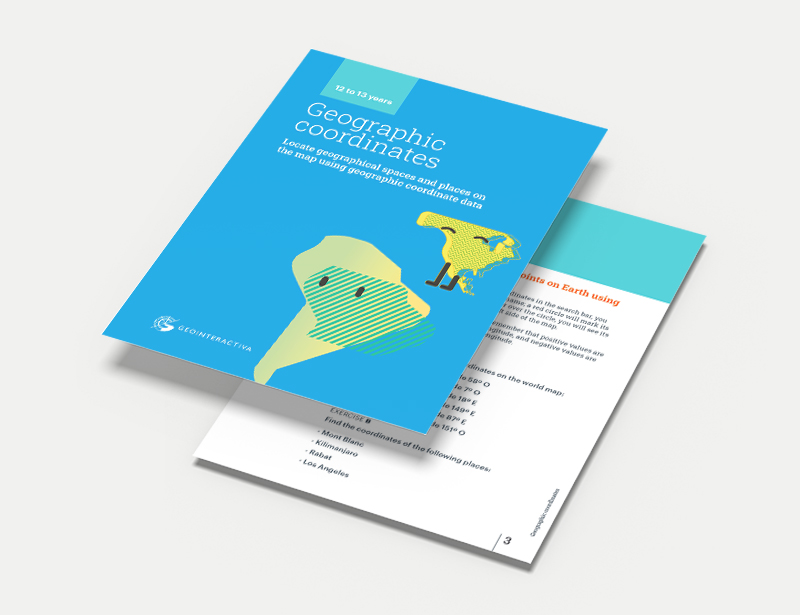
secondary (12-13 years)
Geographic coordinates and terrestrial hemispheres
In this activity you will discover the importance of geographic coordinates to locate geographic spaces and places.
In this downloadable you will find a PDF resource with instructions to energize your classes. On the one hand, we show you which platform tool you will work with and, on the other hand, we propose activities suitable for students aged 12-13.
Do you want your classes to be stimulating? Get started today with Geointeractiva.
we propose to teach geography in a fun way
What will your students learn with this educational activity?
The importance of geographic coordinates for locating geographic spaces and places
The Earth is a huge and diverse planet, composed of a wide variety of ecosystems, climates, and cultures. In geography, one of the disciplines that studies the Earth and its characteristics, it is essential to be able to locate and locate the different points and places that make up our planet. That is why imaginary line systems, such as parallels and meridians, and geographic coordinates, have been developed to precisely identify any point on Earth.
Parallels and meridians: the basis of geographic coordinates
Parallels and meridians are imaginary lines used to divide the Earth into zones and measure the latitude and longitude of any point. Meridians are imaginary circles that run from the North Pole to the South Pole and are used to measure longitude. The prime meridian is the one in Greenwich, which is located in the UK and serves as a reference to measure the longitude of other places.
On the other hand, parallels are imaginary circles that are in a plane perpendicular to the axis of the Earth and are used to measure latitude. The main parallel is the Equator, which divides the planet into two hemispheres: north and south.
The combination of the latitude and longitude of a point allows us to obtain its geographic coordinates, which are measured in degrees, minutes, and seconds. For example, the city of New York is located at 40.7128° N, 74.0060° W, while Sydney is located at 33.8688° S, 151.2093° E.
The importance of geographic coordinates in navigation
One of the most important applications of geographic coordinates is in navigation. Navigators use geographic coordinates to locate themselves at sea and determine their direction and speed. In ancient times, navigators used the sun and stars to calculate their position in the ocean, while today satellite navigation systems like GPS are used.
The GPS (Global Positioning System) is a satellite navigation system that uses radio signals to determine the exact location of an object on Earth. GPS is used in maritime, air, and land navigation, and is an essential tool for safety in travel and the transportation of goods.
Geographic coordinates in cartography
Another important application of geographic coordinates is in cartography. Maps are a visual representation of the Earth and, to create them, it is necessary to use geographic coordinates. Maps can be used for various purposes, such as urban planning, scientific research, or tourism.
Maps can be thematic, physical, or political, and their representation can be in two or three dimensions. Additionally, maps can be created for different scales, which allows them to represent large areas of land or smaller and more specific details. Thematic maps focus on a specific feature of the region represented, such as population distribution, forest density, topography, or climate. Physical maps show the natural features of the region, such as elevation, geological formations, and bodies of water. Political maps, on the other hand, show political divisions such as borders, cities, and capitals.
The representation in two dimensions is the most common way to present a map, where a cartographic projection is used to convert the curved surface of the Earth into a flat surface. However, these projections can introduce distortions, so there are different types of projections used depending on the purpose of the map.
On the other hand, three-dimensional or relief maps allow for a more realistic representation of the terrain, but their elaboration and visualization are usually more complicated.
Regarding scales, maps can be created to cover a wide region, such as a country or a continent, or to represent more specific details, such as a city or a building. The map scale indicates the relationship between distances on the map and actual distances on the surface of the Earth.
Conclusion
In summary, maps can be thematic, physical, or political, and can be represented in two or three dimensions. Additionally, they can be created for different scales, allowing for the representation of large stretches of land or smaller, more specific details.